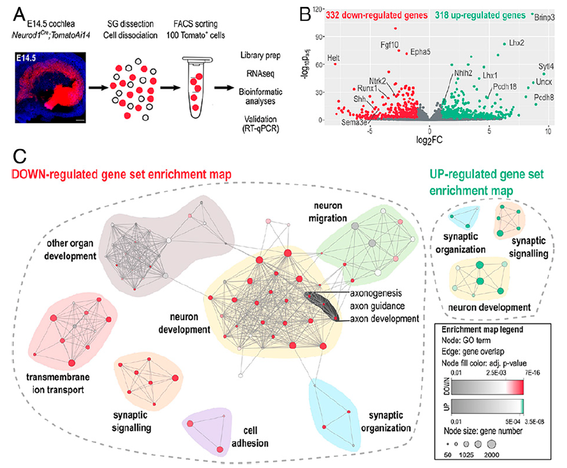ISL1 is necessary for auditory neuron development and contributes toward tonotopic organization. Filova I, Pysanenko K, Tavakoli M, Vochyanova S, Dvorakova M, Bohuslavova R, Smolik O, Fabriciova V, Hrabalova P, Benesova S, Valihrach L, Cerny J, Yamoah EN, Syka J, Fritzsch B, Pavlinkova G. Proc Natl Acad Sci U S A. 2022 Sep 13;119(37):e2207433119. doi: 10.1073/pnas.2207433119.
Significance
Little is known about the molecular determinants of the auditory frequency maps. Our data provide insights into the functional role of the transcription factor ISL1 in the development of auditory neurons and in the formation of the auditory map. In this study, we found that selective genetic deletion of Isl1 by Neurod1Cre resulted in altered molecular and cellular characteristics of auditory neurons, affecting their migration, pathfinding abilities, and formation of peripheral and central processes. This neuronal phenotype was accompanied by hearing impairment, abnormalities in sound processing in the brain, and aberrant auditory behavior. These findings suggest that ISL1 is essential in regulating neuronal differentiation to produce functional auditory neurons.
Abstract
A cardinal feature of the auditory pathway is frequency selectivity, represented in a tonotopic map from the cochlea to the cortex. The molecular determinants of the auditory frequency map are unknown. Here, we discovered that the transcription factor ISL1 regulates the molecular and cellular features of auditory neurons, including the formation of the spiral ganglion and peripheral and central processes that shape the tonotopic representation of the auditory map. We selectively knocked out Isl1 in auditory neurons using Neurod1Cre strategies. In the absence of Isl1, spiral ganglion neurons migrate into the central cochlea and beyond, and the cochlear wiring is profoundly reduced and disrupted. The central axons of Isl1 mutants lose their topographic projections and segregation at the cochlear nucleus. Transcriptome analysis of spiral ganglion neurons shows that Isl1 regulates neurogenesis, axonogenesis, migration, neurotransmission-related machinery, and synaptic communication patterns. We show that peripheral disorganization in the cochlea affects the physiological properties of hearing in the midbrain and auditory behavior. Surprisingly, auditory processing features are preserved despite the significant hearing impairment, revealing central auditory pathway resilience and plasticity in Isl1 mutant mice. Mutant mice have a reduced acoustic startle reflex, altered prepulse inhibition, and characteristics of compensatory neural hyperactivity centrally. Our findings show that ISL1 is one of the obligatory factors required to sculpt auditory structural and functional tonotopic maps. Still, upon Isl1 deletion, the ensuing central plasticity of the auditory pathway does not suffice to overcome developmentally induced peripheral dysfunction of the cochlea.
 ISL1-mediated transcription signature in cochlear neurons.
ISL1-mediated transcription signature in cochlear neurons.